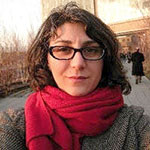Facts:
Interviewed by Magnus Trogen Pahlén.

Is it possible to fight social injustice with city planning? Burcu Yigit Turan argues that we need to understand how planning and urban design reinforces the causes of inequality.
Burcu is an assistant professor at SLU. Her rich academic profile combines the disciplines of urban planning and landscape architecture with semiotics, political theory, cultural geography and cultural criticism.
– You tend not to immerse yourself in social theory when you’re in landscape architecture or any of the other planning design disciplines, says Burcu Yigit Turan. But the knowledge gap in this area needs to be closed, she says.
– We assume that if we - landscape architects - contribute equal quantitative distribution of open public spaces, we can address problems like social inequality and segregation, says Burcu.
But these approaches have failed. Research suggests that income inequalities are increasing, and urban geography has been rapidly shaped under pressure from private property developers. People from different backgrounds are separated according to income levels, and public spaces are territorialized by specific groups in this fragmented geography.
– Low income neighborhoods and their inhabitants are constantly stigmatized by media. Public spaces in central areas are surrounded by shops, cafés, and restaurants. Consumption and fragmented societal order dominate the meaning and culture of public space.
Instead, we need to recognize how inequality is constructed in society, and how we can respond beyond equal distribution of spaces. Many practitioners want to make a positive impact in deteriorating neighborhoods by creating quality public spaces. However, such initiatives typically trigger rent increases, gentrification and gradually cause the displacement of vulnerable groups.
– Public spaces are not separate from larger urban development processes, housing and societal issues. We need to think relationally and build alliances with relevant disciplines to target our actions more consciously and strategically, she says.
The way forward is to be more creative and seek to unsettle established power asymmetries, social polarization and inequalities. And to imagine new models of housing production, community building across different groups from different sides of fault lines to create public spaces that create bonds between people from different backgrounds, as well as empower vulnerable groups.
– Public spaces can be envisioned in more egalitarian, environmentally and socially sustainable and democratic modes of urbanism, which include components such as non-profit housing production, non-profit cafés, space for the sharing economy, collective urban farming etc.,says Burcu.
Landscape democracy, or democracy in planning and design, should be an intellectual, dialogic and creative exercise that responds to societal and environmental crises.
– As landscape architects, we can actively contribute to such change.
But is it hard to be analytical when the framework for theory is based on biased theories, originating from the 1960s.
– Social theories have changed a great deal in recent decades. Today, we know that injustice, inequality and violence are interlinked in complex ways. But we do not apply this to urban design.
Burcu is currently working on theories relating to public space and segregation, diversity and social cohesion. She has shown that many social concepts are, in fact, myths - a mix of ideas from modernist planning and design paradigms, and very few from old social and urban theories. Up-to-date social theory, and theories and research in relevant fields have to be embraced, she stresses.
– I often hear people refer to practice and theory as separate things. We need to decipher where those assumptions come from, and whether they are still valid. We need more research that pushes the theoretical and methodological limits in planning and design fields so as to produce new analytical tools, new empirical findings, and new imaginaries.
However, most funding agencies in the spatial planning and design field support more pragmatic research projects, which produces immediate measurements or solutions for existing practices. Academia should promote the importance of independent, dynamic, critical and advanced research in the field of landscape architecture. The ambition should be to rewrite all study material for students.
– We need more and dynamic research both on issues of human rights, equality and justice, as well as on pedagogy that keeps pace with different fields, since theoretical approaches to issues are dynamically changing. The skills our students should carry are critical thinking, open mindedness, social creativity, communication and strong emotional skills.
More effective communication between practitioners and academia is also key.
– We need to provide practitioners with better knowledge. Practitioners typically feel that they have limited influence over political decisions. And many do not know how to deconstruct the reasoning behind politicians’ decisions, which makes practitioners very pessimistic, Burcu says.
Interviewed by Magnus Trogen Pahlén.

Burcu Yigit Turan, Associate Senior Lecturer, Division of Landscape Architecture, SLU, +4618672533